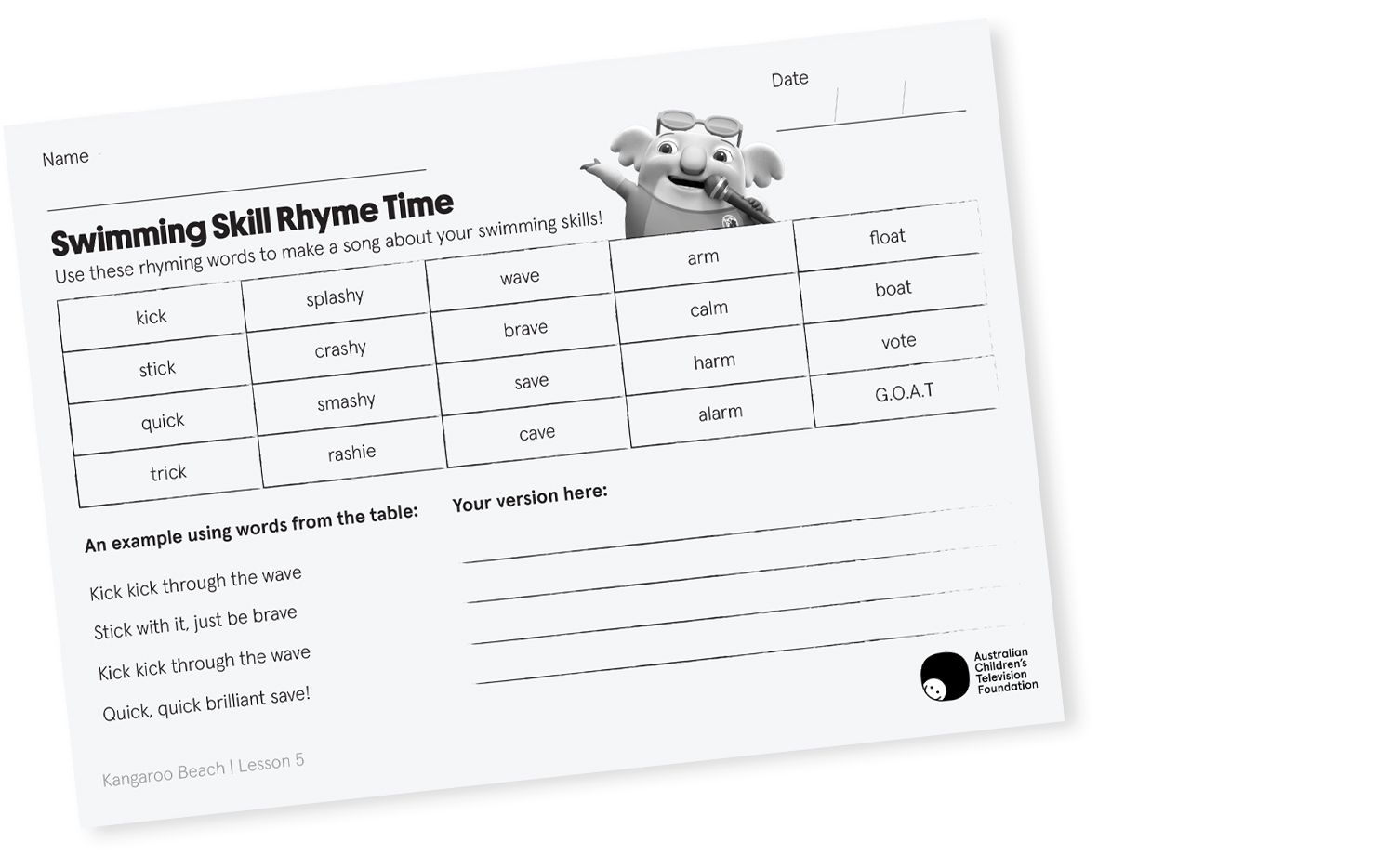
Lesson 4: Swimming

Learning intention: In this lesson, you will explore strategies and messages that keep you safe and movement skills that help you swim short distances.
Task 1: Dig, Dig, Breathe
Watch
Reflect
Thinking about the clip from Kangaroo Beach, talk to your classmates about these questions:
- Pounce says he wants Narelle to work on her ‘technique’ and her ‘stroke.’ What do those words mean?
- What convinces Narelle to have another go at practising her swimming?
- What is a technique or skill that you’ve had to work on and improve through practice?
- What is the rhyme that the cadets use to help Narelle move her arms up and down and lift her face out of the water? Why might it be easier to perform a movement skill if it has a song or rhyme to go with it?
Explore
These exercises help you line up your body correctly, keep your shoulders stable and make your tummy stronger. This is super important for swimming freestyle and being able to float on your back.
Important: Find a soft place to do these exercises, like a carpet or mat. Don't try to push yourself too hard. If something feels uncomfortable, stop. Follow the instructions carefully.
Do the Gemma - Stretch Like A Platypus
- Lie down on your stomach.
- Stretch your arms out in front of you and lift them off the ground.
- Lift your head and chest up off the ground, like you're a platypus looking between your paws as you swim through the water.
- At the same time, lift your legs up, so only your middle section is touching the ground. Your legs are now like a platypus tail. (It's okay if your legs bend a little.)
- Hold the position!
- Gently lower your arms, chest, and legs back down to the floor.
Goal: With practice, see if you can hold the Gemma Stretch for 30 to 60 seconds!
Dig, Dig, Dig and Breathe
- Lie across a chair, bench or a stack of kickboards
- Keep your feet on the ground, while your shoulders and arms are in the air.
- Move your arms the way that Pounce shows Neville’s Mum - dig, dig, dig and breathe
- Don’t forget to turn your head when you breathe!
Extension: remain lying across the chair but lift up your legs and keep your tummy strong, so your feet are off the floor. Practice your arms and your kicking at the same time.
Create
Watch and listen to the song ‘Dig, Dig, Dig and Breathe’ that goes with this episode on the ABC Kids YouTube Channel.
Make up your own rhyme to help you remember a part of swimming that you have learned in your swimming lessons and sing/perform the moves to the tune of ‘Dig, Dig, Dig and Breathe.’ A list of rhyming words has been included to help you.

Task 2: Safety Messages
Watch
Reflect
Thinking about the clip from Kangaroo Beach, talk to your classmates about these questions:
- What important water safety message does Neville fail to follow?
- What does Frizzy say when she tries to remind him?
- Why does Neville ignore the message? What is he feeling at the time that makes him disobey?
- Answer this question to yourself, in your head: can you think of a time when you did not follow a health or safety message, even though you knew it was important to do so? What were you feeling at the time?
- If you are feeling brave, tell a partner about this, or share your story with the class.
Explore
Talk to your classmates. Come up with a list of other health and safety messages that you know, similar to “Never Swim Alone.” Get every class member to write or draw at least one on a post-it note, and then stick them on a big poster. Take turns to share your particular message.
They could be from Kangaroo Beach, school, or out in the community. Examples could include:
- Never swim alone
- Always swim between the red and yellow flags
- Remember to keep the pool gate closed
- Don’t run inside or around water
- Be SunSmart - slip slop slap seek slide
- Swoosh, Glide and Rule Number 5 (eSafety Commissioner)
Task 3: Stay Calm and Float
Watch
Reflect
Thinking about the clip from Kangaroo Beach, talk to your classmates about these questions:
- What is Neville doing before he remembers to stay calm and float?
- Why is floating on your back an important part of staying safe if you get in trouble in the water?
Create
Using paper and materials or a digital design tool, create a poster that teaches one of the water safety messages, “Never Swim Alone” or “Stay Calm and Float.”
Australian Curriculum Links
|
|
Foundation |
Year 1 |
Year 2 |
|
Moving our bodies |
practise fundamental movement skills in minor game and play situations Elaboration: performing a range of water confidence skills such as floating with a buoyancy aid and putting their face in the water |
practise fundamental movement skills and apply them in a variety of movement situations Elaboration: practising gliding forward and backward in the water using arm and kicking movements
|
|
|
Making healthy and safe choices |
identify health symbols, messages and strategies in their community that support their health and safety |
investigate a range of health messages and practices in their community and discuss their purposes |
|
Australian National Benchmarks for Swimming and Water Safety
|
|
Fundamental Stage |
Acquisition Stage |
|
Milestone |
N/A |
Understand and respect safety rules for a range of aquatic environments: Never swim alone |